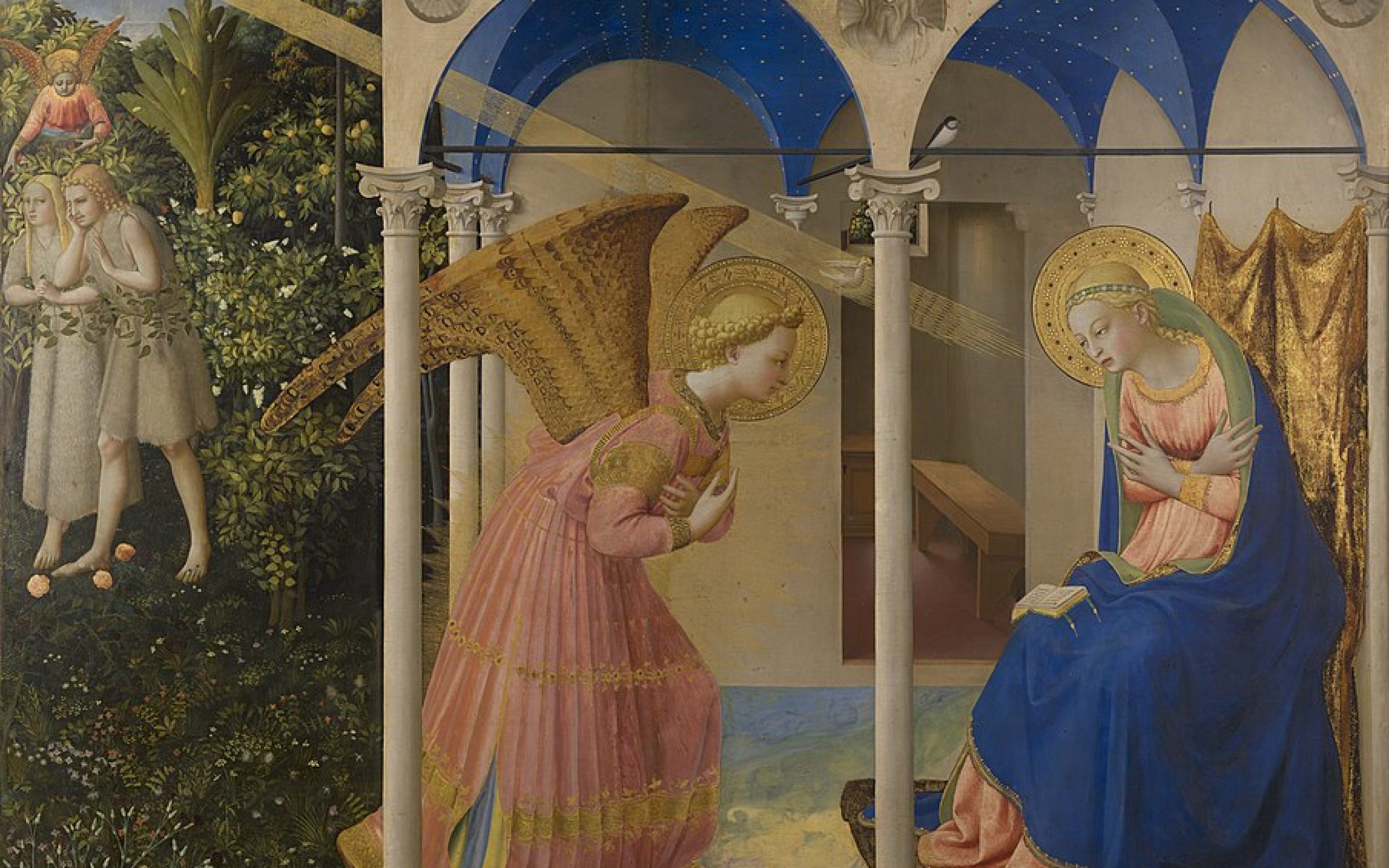The Florentine monk Giovanni da Fiesole painted this picture as an altarpiece for his own monastery, dedicated to St Dominic, at Fiesole on a hill just outside Florence. He made two other versions of the scene in which the Angel Gabriel announces to Mary that she will have a son, Jesus, who will redeem the world. The event is remembered at the Feast of the Annunciation on 25 March, so this article is topical. (Another Annunciation scene was discussed here on 2 May 2020.)
Both of Fra Angelico’s later versions of the subject are in the Convent of St Mark in the centre of Florence itself. All three pictures are distinguished by the serenity and sweetness of colouring that the artist made his own – a beatific style that earned him the name of ‘the angelic brother.’
They all follow the same basic compositional layout, but this version, now in the Prado, Madrid, is visually richer and more complex than the others. It shows the archangel entering deferentially on foot into the Virgin’s study, where she is absorbed in her devotions, as a beam of light from the hand of God Himself descends on her.
Gabriel and Mary occupy two of the three distinctly separate sections of the design, marked out by the architecture of the building: a vaulted room with round-arched openings supported by slender columns. These columns are already classical in design rather than Gothic – the Florentine Renaissance is under way.
The third section, to the left, is a complete contrast: we are in a garden sumptuously green and overflowing with flowers, especially roses. Two figures in sombre clothing are creeping sheepishly away from the gardens and from the house of Mary, while behind them another archangel, Michael, watches closely to see that they go.
These two penitential figures are none other than Adam and Eve, clad in hair shirts, having committed the world-changing sin of disobeying God’s injunction not to eat the fruit of the tree of knowledge – knowledge of good and evil. For this they are banished from the Garden of Eden where God had originally placed them. The artist shows the angel Gabriel simultaneously announcing that Mary will bring to birth the Saviour who will remedy this original and terrible transgression.

The Annunciation c.1425-8
Tempera on panel 154 x 194 in. (391 x 493 cm.)
Madrid, Museo del Prado
Interestingly, when Fra Angelico came to repeat the subject in the Convent of St Mark, he complemented the austere and self-denying lifestyle of the monks by toning down the rather splendid setting in which Mary pursues her devotions here. These later depictions are not images for an altar: they are a subject for private meditation in quiet cells. The ornate, fashionable decoration of the building in the altarpiece is reduced almost to nothing, the star-spangled blue vault becomes quite plain, the gold cloth in front of which Mary sits like a queen is banished: her life is one of humility and self-denial, as though she was herself a member of an enclosed Order of nuns.
In this slightly earlier version painted for a grander setting, the mood is more one of celebration, the colours richer and more varied. Mary is treated as though she were already Queen of Heaven, before whom the archangel pays respectful homage. ‘Hail, Mary,’ he greets her: ‘thou that art highly favoured; the Lord is with thee; blessed art thou among women.’ Having heard the angel’s astonishing prediction, Mary replies: ‘Behold the handmaid of the Lord; be it unto me according to thy word’ (Luke chapter 2).
And having put the Annunciation into its broader theological context by reminding us of the need for redemption in Adam’s Fall, Fra Angelico also fills us in on other episodes in Mary’s life. His altarpiece has a predella beneath it, a tier of smaller scenes showing her espousal to Joseph, her meeting with her cousin Elizabeth, pregnant with John the Baptist, the Presentation of the child Jesus in the Temple, and her death, the ‘Dormition of the Virgin’. Altogether a complex portrait of one of the central figures in the Christian story.
Write to us with your comments to be considered for publication at letters@reaction.life




